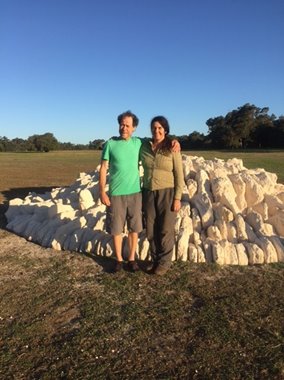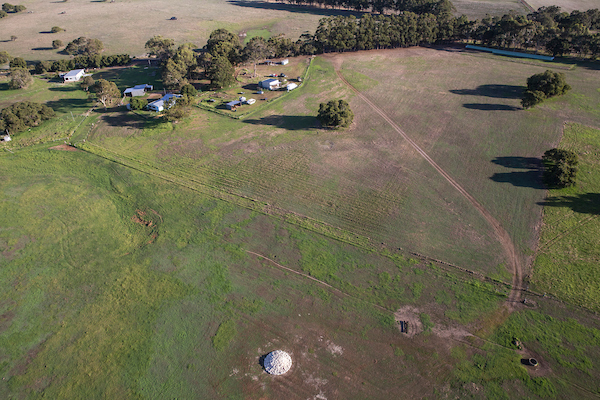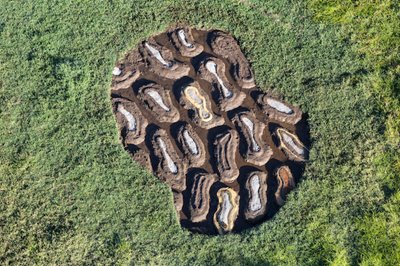 The Farm Margaret River
The Farm Margaret River
Art and Agriculture
Words by Kate Roberts
The Margaret River Region, in the South West of Western Australia, is well known as a home to artists and artisans. As I write, the third Margaret River Region Open Studios event is about to get underway with 120 local artists participating over two weeks.
Darryl Mack and Helen Taylor own a property named The Farm Margaret River - Art and Agriculture (The Farm), on Burnside Road between Cowaramup and Margaret River. The thirty-one hectares is divided between an agricultural lease to a third generation local farming family who run cattle and grow feed on the property, and regenerated and natural bushland. There is a house on the property and the hay shed and shearing/machinery shed have been converted into artist/creative studios, accommodation and workshop space. Darryl and Helen have invited a number of artists to stay on the property already, and are considering their next steps in developing the opportunities for artists to come and work there.
Western Australian environmental artist, Elaine Clocherty is currently living with her family in the house on The Farm, as an artist-in-residence. Elaine’s practice includes site-specific ephemeral sculpture. She has installed site specific works in Aarhus in Denmark, in Poland, Taiwan and Austria and won the Helen Lempriere Sculptor Scholarship at Sculpture by the Sea in Bondi in 2014[1]. The artworks that Elaine makes respond to the material surroundings and bloom and change over time.
The farm presents an opportunity to work with a place in a sustained way; developing a deeper conversation with the land.

In March 2017, Helen and Darryl invited Elaine’s friend and collaborating artist, Chris Booth[2], to come and undertake a residency at The Farm, in conjunction with hers, offering an opportunity for them to work together and develop the complementary nature of their respective practices. Chris Booth is a sculptor and environmental artist based in New Zealand who, over many years, has engaged globally with many cultures including in Australia.
He summarises his ethos as art with land nature spirit community. His artworks often combine stone, organic matter and the land with flora and fauna. By incorporating materials that encourage living agents of transformation, like fungi, Chris makes living kinetic works. Each project has also involved engaging with the local Indigenous community and their traditions related to land. He says,
"Having the privilege of working on such broad and often visionary projects with diverse cultures in many countries over many years has allowed me to develop meaningful principles for making my land art. The underlying most important principle of all has been to create work that promotes a sense of balance, harmony and respect for our precious earth and all that lives on her."
.aspx?width=380&height=252)
At the beginning of his residency, Chris had a vision of a woman in the contours of the land half a kilometer long before him. Following discussion with Elaine, Darryl and Helen and Vivienne Brockman, a Wardandi[3] woman from the local Wardan Aboriginal Cultural Centre, he has completed the first component of the land art form at The Farm. The concept for this artwork emerged from the process as a metaphorical goorbal beela or navel, making it the centre of a body - a female body in this case. A navel, as a metaphor, also speaks to the centrality of water in the Indigenous cultural matrix and alludes to the classical ideas of the omphalos stone and the genius loci or spirit of place. Goorbal Beela - navel (pictured right) is a circular mound, formed by clearing a circle of turf, stacking jarrah logs in the centre, covering the structure with mineral lime then setting broken slabs of limestone on edge in a spiral to form the final surface. Like Chris’s previous living works the mound will change in shape and colour overtime as natural agents alter its components.
Vivienne Brockman has been guiding them in traditional aspects of the land and its agriculture. She has confirmed that, in local Wardandi accounts, this place has always been important to women. Eventually Elaine and Chris hope to realise a full female form on the site. Elaine is currently preparing a submission for the next step of forming a series of terraces around the spring of a winter creek, which corresponds to the female’s lower body (or life-giving area, in Chris’s words).
Elaine has just completed a related work to coincide with the Margaret River Region Open Studios event starting in late April. Acknowledgement (2017) has been formed by clearing an area of grass in a creek bed, shaping the underlying clay and soil into mounds and adding contrasting bands of colour and line in crushed stone and soil from other locations on the property. Elaine says,
"This sculpture acknowledges what happened for the Wardandi people from first contact here in the southwest of WA in 1830 to 1900. Vivienne Brockman explains that as spirits pass over, they move through the water and out to the west. This ephemeral work lies on an east-west axis in the waterway, one of the source tributaries of the Ellen Brook. The piece also includes a soundcloud, of a Celtic song sung by Lucy Ridesdale, Acknowledgement is an offering from my Irish ancestors to the ancestors of the Wardandi."
 Elaine sees The Farm project developing to reflect art and agriculture in a range of ways, taking into account Indigenous traditional practice and the local European history of agriculture in selecting and placing plants and landscaping. If the redevelopment of the paddock to create a growing female form could result in stabilisation of the land and the cleaner running of Ellen Brook downstream, it would represent a triumph of art and agriculture in the artists’ minds. Chris was invited to talk about the project on the local ABC radio. Regarding The Farm, he describes the land as ‘unloved’. When asked about possible offence, Chris is unrepentant – he would like to see the precious spring water source and winter creek (and female form) revegetated and protected from cattle by electric fencing.
Elaine sees The Farm project developing to reflect art and agriculture in a range of ways, taking into account Indigenous traditional practice and the local European history of agriculture in selecting and placing plants and landscaping. If the redevelopment of the paddock to create a growing female form could result in stabilisation of the land and the cleaner running of Ellen Brook downstream, it would represent a triumph of art and agriculture in the artists’ minds. Chris was invited to talk about the project on the local ABC radio. Regarding The Farm, he describes the land as ‘unloved’. When asked about possible offence, Chris is unrepentant – he would like to see the precious spring water source and winter creek (and female form) revegetated and protected from cattle by electric fencing.
Previous destination marketing for the Cowaramup district has focussed on the cow, in the name and in association with local farming. But the name Cowaramup actually comes from the Wardandi word for a local parrot, the purple crowned lorikeet, cowara. The district identity is not a direct concern of The Farm, but bringing Indigenous traditions to the fore through language and art could contribute to Cowaramup’s sense of place - broadening its aesthetic appeal. Many artists have created exceptional site-specific installations and destinations in Southwest WA such as the Understory, Art in Nature[4] sculpture walk near Northcliffe (completed in 2006) that have proved very successful. The Farm could attract more local and international environmental artists and develop further as a more permanent land art destination both for itself and Cowaramup.
[1] https://elaineclocherty.com/ accessed April 2017
[2] http://www.chrisbooth.co.nz/ accessed April 2017
[3] https://www.noongarculture.org.au/noongar/ accessed May 2017
[4] http://www.understory.com.au/ accessed April 2017
Kate Roberts is the Head of Membership Services at Artsource, with a background in museum management and materials conservation. Kate trained in conservation at the University of Canberra and has a post graduate qualification in Museums Studies from Massey University in NZ. Kate is from New Zealand and has lived in WA since early 2014.
Images top to bottom:
-
Chris Booth and Elaine Cloherty with goorbal beela - navel, 2017. The Farm Margaret River - Art and Agriculture artists-in-residence. Photographer: Kate Roberts.
-
Chris Booth, goorbal beela - navel on The Farm Margaret River - Art and Agriculture, 2017. 7m diameter x 1.5m height. Photographer: Martine Perret.
-
Chris Booth, goorbal beela - navel, 2017. 7m diameter x 1.5m height, The Farm Margaret River - Art and Agriculture. 2017 Photographer: Martine Perret.
-
Elaine Clocherty, Acknowledgement, 2017. Clay soil crushed stone, 10m x 8m x 0.4m. The Farm Margaret River - Art and Agriculture. Photographer: Martine Perret.